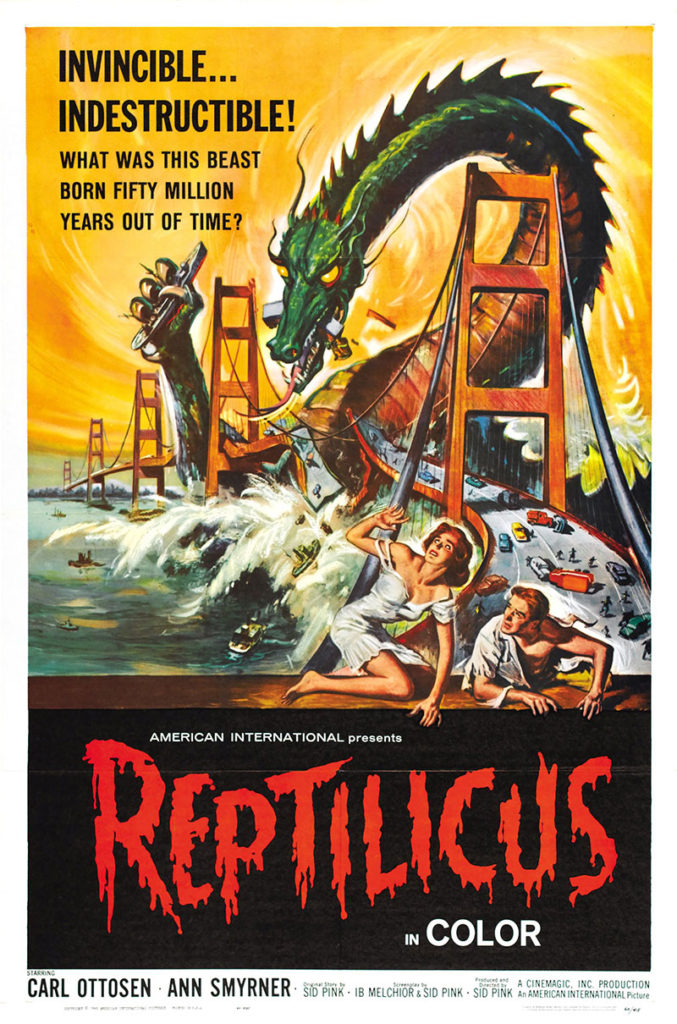The October Horrorshow Giant Monstershow carries on! After spending nineteen straight films in the 1950s, we have our first feature from after that defining decade of the monster flick, but all that’s changed is that today’s movie was filmed in color.
Reptilicus, from 1961, is a joint Danish-American monster flick that was filmed in two versions. One was shot in Danish, directed by Poul Bang, and that’s the version Danish audiences saw. The other version was directed by Sidney Pink, used most of the same performers, but was shot in English, for distribution in the United States. But, American International Pictures, which distributed the film in the US, didn’t like the English cut, and ordered substantial changes. The changes were enough for Pink, who was also the film’s producer and a credited screenwriter, to take AIP to court. It was a brief dispute, but an indication of divergence between the two versions of this film. I’m curious just how different the Danish version is from the English, but not curious enough to sit through this dog again, at least for now.
A drilling team in Lapland unearths the frozen flesh of a prehistoric creature. It has been trapped in permafrost for tens of millions of years. We know this because Reptilicus is the type of monster flick that is packed full of expository scientists. It is these characters’ jobs in these films to make sure every question an audience member might have about the monster is answered. Monster flicks abhor ambiguity when it comes to a monster’s origins. Why, I have no idea. Where a monster comes from is peripheral to the actual plot of these films, but since the early ’50s it’s been de rigueur.
Personally, I prefer the approach used by Ray Kellogg in The Giant Gila Monster (I can’t believe I’m praising that flick). Kellogg didn’t provide an origin for his monster, nor did he have any scientist characters on hand to exposit, should he have so desired. A monster appears, and people have to deal with it. Leaving a little mystery doesn’t hurt things at all.
The secondary purpose of the scientist characters is to come up with a means of battling the dread beast. In this second aspect, the scientists are more important than in most monster flicks.
After the flesh is discovered, it is brought back to a lab, where it thaws. The scientists discover that the ancient flesh still lives, and when provided nutrients, grows a new body, along the lines of simple organisms like flatworms.
Fully grown, the flesh is, of course, the monster Reptilicus. The creature bursts from the lab, travels to Copenhagen, and begins to lay waste to the city. By now, an American general is on the case. General Mark Grayson (Carl Ottosen) wants to blow the beast to  smithereens. Thank goodness, then, for those scientists, who point out that the creature’s remarkable regenerative ability would mean that any small piece of the monster left behind would grow in time into another full-blown beast. The scientists need to find a way to kill the monster without rockets and bombs. They do, because that’s how these things end. It’s the journey that concerns us viewers.
smithereens. Thank goodness, then, for those scientists, who point out that the creature’s remarkable regenerative ability would mean that any small piece of the monster left behind would grow in time into another full-blown beast. The scientists need to find a way to kill the monster without rockets and bombs. They do, because that’s how these things end. It’s the journey that concerns us viewers.
The first act of this movie is a real drag. It’s anonymous — no different than any random monster flick from the previous decade. It being filmed in Denmark, it’s free of the American teenager, but all the other monster tropes are present. It’s when the monster appears that this flick takes off. The monster is…unique. It shows more artistic skill than the monster from The Giant Claw, but even less technical proficiency when it came to manipulating it. That’s quite a feat.
I have never seen special effects in a film quite like that used by the effects team in this one. They might be pioneering, in that no other effects team would be caught dead using these techniques. When the monster eats people, the effect is similar to that of a rubber snake eating a twitching cardboard cutout. That’s about as literal a description as I can come up with and it’s still impossible to picture in one’s head without having actually seen it.
Most of the time the monster is just a neck and a head, with some very loose marionette-like swaying back and forth. The puppet can’t even close its mouth, but that’s okay, as the creature clearly has no throat. It is, perhaps, the worst monster puppet I’ve ever seen in a movie. When it first shows up, it’s so out of alignment with the look and feel of the rest of the film that it feels like a joke. The film jumps back and forth in quality, shot to shot, in scenes with the monster. The film stock looks completely different, as if the monster sequences were shot on cheap commercial stock, like 8mm or 16mm. The differences are jarring.
While the effects are incompetent, they are hilariously so. The scenes with people in this movie are tedious. They’re dry, overlong so the filmmakers could stretch a razor-thin budget, poorly-acted, and even more poorly-written. But when the rubber monster shows up, this bottom-feeding piece of garbage becomes a true laugher. It’s impossible to be prepared for the appearance of the monster. It’s so funny that it made this movie worth watching…once. Alien: Resurrection is a better movie than Reptilicus.
